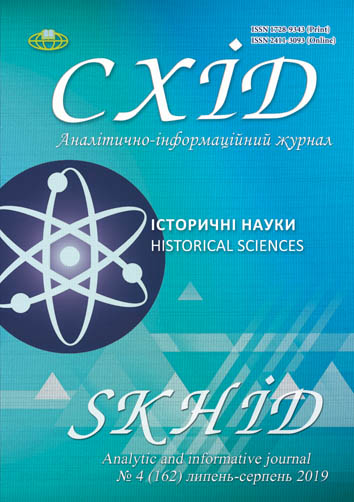General trends in military specialists’ training of the Armed Forces of Ukraine: historical aspect
DOI:
https://doi.org/10.21847/1728-9343.2019.4(162).176936Keywords:
military education, military personnel policy, the Armed Forces of Ukraine, retraining and developmental training courses, “Leadership courses”Abstract
The article is devoted to analysis of general trends in the Armed Forces of Ukraine military specialists’ training are scrutinized in this article from a historical perspective. The factors of reduction in the first officer positions recruitment before the Russian Federation military aggression against Ukraine are analyzed. Those factors are: drawbacks in the state order planning for the training of tactical level specialists, absence of the other sources of officers admission to the first officer positions because of the lack of appropriate legislative framework, and an unsuccessful implementation of the personnel policy and military education tasks that consequently led to a significant officers’ training lag behind the real needs of the Armed Forces of Ukraine. In addition, the measures taken by the Defense Agency to stabilize the situation and eliminate the existing incompleteness of the first officer positions are considered. Since 2015, the Defense Agency has suggested several effective methods, primarily in the form of course training for non-commissioned officer personnel who have higher education with the further assignment to the officer personnel positions and award of a military rank of “second lieutenant”. The Defense Agency also has run an experiment that involves the enrollment for an experimental program “Leadership Courses” of civil citizens who obtained a bachelor’s degree and higher for training (up to 12 months) for the military service under contract in the first officer positions. The suggested forms and means of the servicemen’s training are continuously adapted in order to find an optimal way that has to provide the conditions for mastering a certain military specialty on a professional level. The author has studied the latest forms of junior officers’ training taking into account the standards of NATO member states. The concept of “military specialists’ training” is analyzed in the context of implementation of military education tasks and military personnel policy for the first time. The future research perspective consists in the need to provide the possible ways of the world-leading countries’ positive experience usage in order to create an effective career management system for military specialists.Downloads
References
Bila knyha 2008. (2010). Oboronna polityka Ukrainy. Kyiv: Vydannia MOU. (In Ukrainian)
Dumenko, M. P. (2016). Analiz funktsionuvannia systemy kadrovoho zabezpechennia pid chas dii osoblyvoho periodu u 2014- 2015 rokakh. Suchasni informatsiyni tekhnolohiyi u sferi bezpeky ta oborony. 2(26), 132-140. Retrieved from http://irbis-nbuv.gov.ua/cgi-bin/irbis_nbuv/cgiirbis_64.exe?C21COM=2&I21DBN=UJRN&P21DBN=UJRN&IMAGE_FILE_DOWNLOAD=1&Image_file_name=PDF/sitsbo_2016_2_25.pdf. (In Ukrainian)
Hapeieva, O. L. (2013). Systema kadrovoho menedzhmentu v konteksti reformuvannia Zbroinykh Syl Ukrainy. Hileya: naukovyy visnyk, 71. (In Ukrainian)
Hrebeniuk, M. V. (2012). Evoliutsiia kadrovoi polityky "skorochennia" u Zbroinykh Sylakh Ukrainy v 1992-2012 rokakh. Visnyk Natsionalnoyi Akademiyi kerivnykh kadriv kultury i mystetstv, 3, 216-222. (In Ukrainian)
Kolos, R. L. (2004). Pidhotovka ofitserskykh kadriv dlia Zbroinykh Syl Ukrainy za dosvidom Viiskovo-inzhenernoho instytutu 1991-2000 rr. (Extended abstract of Candidate’s thesis). Kyiv. (In Ukrainian)
Kuravskyi, V. H. (2012). Stvorennia Povitrianykh Syl Zbroinykh Syl Ukrainy (1991-2005 rr.): istorychnyi aspekt (Extended abstract of Candidate’s thesis). Kyiv. (In Ukrainian)
Kuzmuk, O. I. (2013). Formuvannia ta evoliutsiia Voiennoi orhanizatsii (sektoru bezpeky i oborony) Ukrainy (1991-2012). Kyiv: National Defense University of Ukraine. Ivan Chernyakhovsky. (In Ukrainian)
Medvid, A. P. (2015). Kadrova polityka yak efektyvnyi vazhil rozvytku sluzhby tsyvilnoho zakhystu Ukrainy v suchasnykh umovakh. Naukovi zapysky Instytutu zakonodavstva Verkhovnoyi Rady Ukrayiny. 3, 122-126. (In Ukrainian)
Nashyvochnikov, O. O. (2016). Stvorennia osnov Viiskovo-Morskykh Syl Ukrainy (1991-1994). (Extended abstract of Candidate’s thesis). Kyiv. (In Ukrainian)
Nechepurenko, A. O. (2018). Deiaki pytannia kursovoi pidhotovky molodshykh ofitseriv: dosvid NASV. Abstracts of Papers: Perspektyvy rozvytku ozbroiennia ta viiskovoi tekhniky Sukhoputnykh viisk (P.134) Lviv. (In Ukrainian)
Nechepurenko, A. O. (2017). Deiaki pytannia prokhodzhennia viiskovoi sluzhby na suchasnomu etapi rozbudovy ZS Ukrainy: istoryko-pravovyi analiz. Hileya: naukovyy visnyk, 120. P.93-95. Retrieved from http://gileya.org/index.php?ng=library&cont=long&id=144 (In Ukrainian)
Neshchadym, M. I. (2003). Viiskova osvita Ukrainy: istoriia, teoriia, metodolohiia, praktyka. Kyiv: VPTs "Kyivskyi un-t". (In Ukrainian)
Radetskyi, V. H. (2009). Pytannia transformatsii oboronnykh struktur Ukrainy ta udoskonalennia systemy viiskovoi osvity. Nauka i oborona. 1, 15-18. (In Ukrainian)
Sokal, I. I. (2004). Stvorennia systemy protypovitrianoi oborony Ukrainy (1991-2000 rr.): istorychnyi aspekt. (Candidate’s thesis). Kyiv. (In Ukrainian)
Telelym, V. M. (2013). Pidhotovka viiskovykh fakhivtsiv z vyshchoiu osvitoiu: systemnyi pidkhid. Viyskova osvita. 1, 3-15. (In Ukrainian)
Vorobiov, H.P. (2013). Pidhotovka ofitseriv dlia Sukhoputnykh viisk Zbroinykh Syl Ukrainy: istoriia ta perspektyvy. Viyskovo-naukovyy visnyk. 19, 12-23. (In Ukrainian)
Downloads
Published
How to Cite
Issue
Section
License
Copyright (c) 2019 Andrii Nechepurenko

This work is licensed under a Creative Commons Attribution-NonCommercial-NoDerivatives 4.0 International License.
1. Authors bear responsibility for the accuracy of facts, quotations, numbers and names used.
2. Manuscripts are not sent back.
3. The publisher does not always agree with the authors' opinion.
4. The authors reserve the right to authorship of the work and pass the first publication right of this work to the journal under the terms of a Creative Commons Attribution-NonCommercial-NoDerivatives 4.0 International License. This license allows others to distribute (copy) the published work for non-commercial purposes, provided there is mandatory attribution to its authors and a link to the first publication in our journal.
5. The authors have the right to conclude separate supplement agreements that relate to non-exclusive work distribution in the form in which it has been published by the journal (for example, to upload the work to the online storage of the journal or publish it as part of a monograph), provided that the reference to the first publication of the work in this journal is included.

